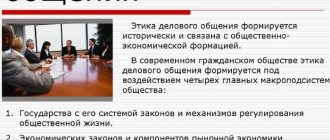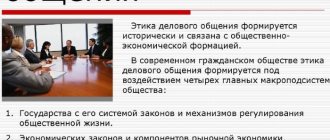Professional communications are a prerequisite for allowing company employees to effectively interact with each other. The pace of work of the entire enterprise directly depends on how quickly and easily the transfer of information occurs.
Professional communications play an important role when a manager makes the most effective decisions and communicates them to the team. If they are poorly established, then this threatens the emergence of negative consequences, which can be expressed in errors in the chosen decisions, in the emergence of misunderstandings between employees and the manager, as well as in the deterioration of interpersonal relationships.
Definition of the concept
Professional communications are interactions carried out in the sphere of official relations. Their main goal is to achieve the intended results, solve assigned tasks, and optimize certain activities. Moreover, each of the participants in professional communications has his own status, being a boss, subordinate, colleague or partner.
In cases where people at different levels of the career ladder (executor and manager) communicate with each other, we can talk about subordinate communications. After all, the vertical relationship is clearly visible here. When implementing interaction based on the principle of equal cooperation, we can talk about horizontal communications.
Relevance of the issue
People encounter professional communication every day. It occurs at work and in schools, universities and official institutions. This is communication between students and teachers, subordinates and superiors, competitors, partners and colleagues. In order to achieve the goal set before him, each person must be familiar with the means and principles of such communications, because partners need to communicate in the same language (both literally and figuratively), have a common social experience and understand each other.
Compliance with the basic conditions of business communication
How to make communication in professional activities as effective as possible? To do this, you will need to fulfill a number of conditions. First of all, communication must have a clear purpose. At the same time, the interest of all persons involved in this process is important in achieving it. An example would be concluding an agreement, establishing connections, coordinating events, developing the most favorable terms of cooperation, etc.
All participants in professional and business communication need to communicate with each other, and do this regardless of personal likes or dislikes. In this case, observance of subordination, job roles, business etiquette and formal restrictions is mandatory. The latter concept implies not only the implementation of various protocols, routines and regulations, but also the banal need to control the strength of one’s own emotions and respect the interlocutor.
In addition, one of the necessary conditions for the most effective implementation of business communication in professional activities is its controllability. The head of the company, as the person most interested in solving the problems facing the team, must first take care of such a moment. It is important for him to motivate his employees to find the optimal solution, because otherwise they will remain passive observers who do not offer any ideas.
Business communication tools
Professional communication is the meaningful desire of one person or a whole group of people to motivate one employee or the entire team to take action that can somehow change the situation or turn the conversation in a different direction.
There are a number of tools available to achieve this. Thus, the means of professional communication include:
- Regular mail. Of all the means of business communication, it is the most ancient. And in this regard, traditional mail has a number of disadvantages. They consist in the low speed of message transmission, more complex design of letters (compared to other types of communications), etc. And this is not to mention the fact that this system does not always work at the proper level. But regular mail is still used today as a means of professional communications. Its main advantage is a very acceptable method of transferring important documents between partners. In business relations, a method such as sending telegrams can be used. This service is also provided by mail.
- Telephone communications. This is a very efficient means of business communication. However, telephone negotiations have no legal force. This point should be taken into account when using professional communications, using other means.
- Email. This relatively new means of business communication enjoys well-deserved popularity. One of its main advantages is the combination of the form of written communications (fixed text) with the qualities that oral communication has, in the form of speed of information transfer and the ability to receive an almost instant response. Such qualities make it possible to make e-mail one of the main means used for transmitting informal messages.
- Fax machine. Using a special device, you can very quickly transfer a copy of any document to your partner. Speed is the undoubted advantage of faxing. However, documents transferred in this way do not have legal force, because they do not have original signatures and seals. That is why, in most cases, fax as a means of communication is used only for the prompt transmission of documents. They can be accepted for execution only if the originals are sent after them by regular mail. It is worth keeping in mind that using faxes it is prohibited to transmit documents marked “For official use” or “Secret”.
Language of communication in the business environment
The concept of "language" is used to refer to the system of signs through which people think and speak. It is also a way of expressing a person's self-awareness.
The language of business communication is an official business style of speech intended for communicative interaction in a professional business environment, as well as other related areas.
Business language is a system of communication in oral and written form that regulates working relationships.
The official style of writing has the following features:
- concise presentation of information;
- strictly required form;
- special terminology, cliches, clericalism;
- narrative nature of written speech;
- almost complete absence of emotionally expressive means of speech.
Business oral speech has three components:
- content component (characterized by clarity and logic);
- expressive component (characterizes the emotional side of information);
- incentive component (recognized to influence the feelings and thoughts of the interlocutor).
The language of business communication of the subject of interaction is assessed according to the following indicators:
- Lexicon. The larger it is, the more expressive and effective the speech is. Moreover, the interlocutor is a literate, educated, cultured person.
- Vocabulary composition. In addition to how many words a person knows, what kind of words they are is equally important. Words used in common parlance, as well as obscene and slang expressions are unacceptable in the business environment.
- Pronunciation. The written language of the organization is the official state language of the country or the international business language (English). Business communication in the form of oral speech is complemented by pronunciation. It is customary to speak in a dialect that is closest to the literary language.
- Stylistics and grammar. The language must be literate. Correct direct word order in a sentence, absence of tautology, filler words, etc.
Business conversation
The basis of professional communication has always been and remains oral contact. It is carried out between people who are interconnected by the interests of the business, and also have the necessary powers to solve problems that have arisen and establish partnerships.
Such conversations are a means of professional communication, containing all the advantages that telephone communication and the exchange of written information lack. The fact is that business communication:
- carried out in conditions of close contact, when it is possible to focus one’s attention on only one interlocutor or on a small group of people;
- creates conditions under which it is possible to establish personal relationships;
- involves direct contact.
Business conversation primarily refers to oral speech. And it, in comparison with the written form, has a number of significant differences. During such a conversation, it becomes possible to directly influence the interlocutor or a group of people. In this case, gestures and facial expressions, intonation, etc. are used. In addition, direct communication does not leave time for preliminary thinking. That is why in a business conversation, casual forms of communication are often used, and some stylistic and grammatical features also occur.
Business conversation, used as the basis for professional communication, is distinguished primarily by the logic of constructing thoughts. Based on existing practice, it can be argued that businessmen who have excellent judgment and concepts, who are able to convincingly prove and make correct conclusions, achieve success much faster than those business people who do not possess these skills.
Professional conversation is characterized by its own psychological culture. It lies in the ability of interlocutors to make a good impression on others, create a friendly meeting atmosphere, use special techniques that protect against incorrect questions, listen to their opponents to the end and, if necessary, refute their arguments, use techniques that allow for conflict-free communication.
Stages and forms of business communication
Communication is the process of establishing and developing contacts between people and groups of people. The nature of communication is determined by the goals of joint activity, and therefore can be different.
Business communication is a type of communication, the specifics of which are determined by the impossibility of professional and other related activities outside of communications with other people.
Business communication is a type of communication in which information is exchanged in the socio-legal and economic sphere of human activity in order to solve a specific problem (commercial, industrial, scientific and others).
In addition to business, there are secular, formal-role, intimate-personal, and manipulative types of communication. A distinctive feature of business communication is that the subject of communication is always significant, and the subject of communication is clearly defined and well known.
Business communication consists of stages:
- Establishing contact. This is the stage of acquaintance, when the partners are introduced to each other, the self-presentation of each of them and the exchange of general phrases.
- Orientation in the situation. The second stage, when subjects seek to understand each other’s positions and identify their own.
- Discussion. The stage at which specific business issues and objectives are considered and discussed.
- Problem solving. The stage of finding agreement between partners and an optimal mutually beneficial solution.
- Ending the contact. Stage of regulated termination of communication.
The purpose of business communication always lies outside the interaction of its subjects. But the means to achieve the goal are determined taking into account the interests and needs of all communicators.
The goal of business communication is productive and effective cooperation between partners.
Any communication includes three complementary processes: social perception - perception and understanding of the partner; communication – exchange of information; interaction – exchange of actions.
These processes in the business environment are strictly regulated; there are rules and norms for business interaction and etiquette.
The communication process is of particular importance. One wrong or inappropriate word can lead to significant negative consequences, such as loss of a client, partner, profit, and so on. But perception and interaction are also equally important.
Intercultural connections
Today, the world is increasingly embracing the process of globalization. That is why intercultural professional communication comes to the fore. To implement it, specialists are needed who not only know a foreign language. They need to own it from a business communication perspective.
Most often, such professional communications take place in English. It is the main means of communication at the interstate level.
English in the field of professional communication is a modernized and simplified version of the English language as a whole. It is characterized by the presence of standard cliche phrases, as well as all kinds of templates. A specialist needs to know them and be able to use them in certain situations.
If a translator is invited to a business meeting by a businessman, in professional communication such a specialist will not proceed only from his life experience and the behavior that is accepted in his native cultural environment. Taking into account the behavioral characteristics of other peoples will help avoid misunderstandings, mistakes and problems in the conversation.
In intercultural professional communication, it is necessary to know the interpersonal norms of relationships that are accepted in a particular society. Namely, non-verbal and verbal languages of communication. The first of these include various wordless signals that communication participants send to each other. They often do this simply unconsciously. It is worth keeping in mind that knowledge of non-verbal and verbal languages in professional communication of an intercultural nature is the key to a successful meeting. The specialist must be aware of the timbre of speech adopted by a particular people, the volume of pronunciation, intonation, facial expressions, postures, etc. The norms for their use during a conversation may have some differences. A striking example is the traditional American smile. In Russia it is considered insincere and artificial. Americans, on the contrary, believe that Russians are too gloomy, rude and serious.
Argumentation phase
It is advisable to imagine the course of argumentation in advance and even rehearse it. Important to remember:
- It is necessary to operate in simple, clear, precise and convincing concepts.
- The method and pace of argumentation must correspond to the temperament of the interlocutor.
- Arguments and evidence explained separately achieve their goal much more effectively than when they are presented all at once.
- Three or four strong arguments achieve more impact than many “average” arguments.
- Argumentation should not be declarative or look like a monologue of the “main character”.
- Precisely placed pauses have more impact than a stream of words.
- The interlocutor is better influenced by the “active” construction of the phrase than by the “passive” one when it comes to evidence (for example, it is better to say “we can do it ...” than “it can be done ...”)
- Empty phrases indicate a weakening of attention and lead to unnecessary pauses in order to gain time.
- You need to conduct your argument correctly in relation to your interlocutor.
- You can continue to operate only with those arguments that are accepted by the interlocutor. It is necessary to adapt the arguments to the personality of our interlocutor, i.e.:
- Direct your argument to the goals and motives of your interlocutor.
- Avoid simply listing facts, but instead state the benefits or consequences of those facts that are of interest to the interlocutor.
- Use only terminology that is understandable to the interlocutor.
- Test the impact of arguments with cross-questions to monitor the level of understanding and perception of the interlocutor.
- Do not forget that excessive persuasiveness causes resistance from the interlocutor.
- Comparisons should be based on the experience of the interlocutor.
Training of specialists
How are problems with interstate business communication solved? Successful negotiations require the presence of a highly qualified translator in the field of professional communication, who has both specialized and general cultural knowledge. Russian universities train such specialists.
At the same time, a program called “Translator in the Field of Professional Communication” is actively used. It allows you to acquire the skills to communicate effectively in modern business and cultural exchanges.
Main functions
Among the features of professional communication, its rather complex system is distinguished. It consists of many levels, covering not only a specific organization, but also the external environment. Let's consider the main functions of professional communication.
- Informational. Professional communications are called upon to play the role of a certain intermediary. With its help, ideas, decisions and messages are exchanged between employees. The information function of business communication is necessary to achieve the goals of the organization, as well as to eliminate problems that arise during this process.
- Motivational. Professional communications contribute to the desire among employees to perform their tasks more efficiently. This is the motivational function of professional communications. In this case, the leader uses such means as order, persuasion, suggestion and request.
- Test. Using hierarchical subordination, this function is designed to monitor the behavior of company employees.
- Expressive. With the help of this function, professional communications contribute to the satisfaction of social needs by expressing experiences and feelings about what is happening.
- Communicative. This function is very specific. With its help, typical errors and problems that arise during business communication are identified and resolved, and principles of optimal behavior are formulated.
The functions of professional communications can also be considered from the point of view of ensuring the life of the company as a whole. In this case the following occurs:
- Regulatory function. When communicating, there is an indirect or direct impact on the employee who is the object of management. This function contributes to the organization of joint actions in the team, coordination and optimization by the leader of all actions performed by the team.
- Social control function. Any of the methods of solving the problems of an organization, as well as its forms and operating principles, have a clearly defined normative character. The regulation of all these provisions, found in the instructions and orders of the head, helps to ensure the organization and integrity of the institution, as well as the consistency of the joint actions of each member of the team. To maintain this direction, professional communications exercise their social control.
- Socialization function. It is one of the main things in the work of any leader. This function allows young employees to participate in joint activities, who begin to master communication skills and abilities, learn to navigate a communication situation, speak and listen. All this is very important not only for the purposes of interpersonal adaptation, but also for the implementation of professional activities. At the same time, young people acquire a tolerant, interested and friendly attitude towards other employees and the ability to act in order to complete a collective task.
- Social and pedagogical. In the process of carrying out professional communications, there is a process of training, education and development of the employee’s personality while transferring practical experience to him. Thanks to systematic contacts that appear during joint activities, all participants in communication gain knowledge both about themselves and about partners, as well as about optimal options for solving the problems facing the team. Mastering practical skills sometimes becomes for some employees a possible compensation for missing professional knowledge. And this is ensured by the social and pedagogical function of communications.
Information transfer phase
Information transfer is a process during which interlocutors try to create a sufficient information base for each other.
This phase develops according to the following pattern: attention and the degree of assimilation of information gradually decrease, and the influence of your authority on the interlocutor, after some decrease, increases again. The information transfer phase consists of the following elements:
- Informing the interlocutor: general and targeted.
- Posing mostly open questions. It is recommended to ask closed questions not when you need to obtain information, but only in cases where you want to speed up obtaining consent or confirmation of a previously reached agreement.
- Listening to your interlocutor.
Conditions for “good listening”:
- Condition 1. No side thoughts.
- Condition 2. While you are listening, you cannot think about the next question or prepare counterarguments.
- Condition 3. You must concentrate on the essence of the subject, crowding out everything unimportant from your head. Particular attention is given to speeches by unprepared speakers.
- Condition 4. You should concentrate only on the topic in question.
- Observing the reaction of the interlocutor.
If you notice some kind of reaction from your interlocutor, then you need to check it by asking whether you interpreted this reaction correctly.
Basic principles
Professional communications proceed on the basis of:
- Interpersonality. Such communication is characterized by diversity and openness of interaction between people. This principle is based on personal interest in each other. And this despite the fact that the communication is business-oriented. Such communication inevitably bears the features of interpersonal contact.
- Focus. This principle of professional communications is multi-purpose, because the process of business communication, along with the intended information load, also carries a hidden goal. For example, a manager, informing the team about the statistical data he has, wants to point out the problematic aspects of a particular area of activity. At the same time, most likely, on an unconscious level, he strives to demonstrate to those present his eloquence, erudition and intelligence.
- Continuity. This is another principle of professional communications. It lies in the fact that when we come into the field of view of our business partner, we become the initiators of continuous contact with him. At the same time, communication occurs not only at the verbal level. The partner constantly receives behavioral messages from which he can draw appropriate conclusions.
- Multidimensionality. In the course of professional communications, at least two aspects of interpersonal relationships are realized. The first of these is the transfer of business information and maintaining the established contact. The second is a broadcast of the emotional attitude towards the partner (it can be positive and negative).
Moral standards of professional communications
Each participant in business communication must have:
- Honesty. Having such a character trait, people refrain from lying and deception. However, even those who consider honesty to be an inviolable standard of business behavior still have to lie sometimes. In this case, people have to make a choice between alternatives that do not satisfy them. However, you must always tell the truth. Lying is justified only when choosing the lesser of two evils, when circumstances require it.
- Decency. This characteristic inherent in a person is expressed in the unity of his actions and beliefs. Decent behavior is the exact opposite of duplicity and hypocrisy. Such a person will always fulfill what he promises. For example, an employee will definitely help his colleague when performing a work task. This will happen even when it is not so easy for him to do it, but he made a promise.
- Justice. This character trait presupposes the absence of bias and objectivity in assessing other people and their actions.
- Responsibility. This trait of a participant in business relations is manifested in the extent to which he is responsible for his words, observes moral standards and fulfills his obligations.
The concept of professional communication of a police officer, its types and functions
Professional communication of a police officer -
This is the process of collecting information necessary and useful for the prevention, suppression and investigation of crimes, during which there is a mutual perception of the policeman and citizens, mutual assessment and mutual influence of the interlocutors on each other.
By type, professional communication can be verbal and non-verbal.
Verbal communication -
it is communication through words.
Non-verbal communication
includes gestures, postures, facial expressions, pantomime.
Functions of professional communication
1. Information and communication.
In the process of professional communication, a police officer receives information of operational and official interest.
2. Emotional and communicative.
In the process of professional communication, a policeman and a citizen exchange not only information, but also adopt each other’s emotional states. So the bad mood of one of them negatively affects the emotional state of the interlocutor.
3. Regulatory manager.
In the process of professional communication, a policeman and a citizen manage each other’s behavior. For example, an employee says to a citizen: “Since you do not have documents proving your identity, I ask you to come with me to the duty station to establish your personal data.” The citizen is forced to either submit to the demands of the law enforcement officer or try to refuse to comply with them. In any case, he is forced to control himself in connection with the demand made by the policeman.
Stages of professional communication
1. Mutual assessment.
Mental “reading” of behavioral characteristics, appearance, drawing up a primary psychological portrait
interacting person.
It should be noted that psychological information about another person depends on the specific situation of communication and the reflection of his personal properties, the degree of acquaintance with him, the presence of certain information about him in characteristics, records, criminal and operational search cases, stories about him from other employees, etc. P.
When directly observing a person, the subject of mental “reading” is his verbal and non-verbal acts
behavior:
speech, its content, direction, logic,
duration, expressiveness, features of vocabulary, grammar,
phonetics;
expressive movements, facial expressions and pantomimes, gestures,
expression of face, eyes, body;
movements, movements and postures of a person, the distance between
people, rapprochement, contact;
physical influence on another person (touching, patting, stroking, supporting, joint actions, pushing, pushing, hitting, etc.).
Of great importance for drawing up a psychological portrait is the analysis of a person’s external appearance: the characteristics of his clothing and manner of dressing (neatness in wearing clothes, following fashion or ignoring fashion, imitating the wearing of clothes by other people, for example, outstanding artists, athletes, politicians, etc.)
etc.
When drawing up an initial psychological portrait of a person interacting with a law enforcement officer, it is advisable to focus on the analysis of the following parameters
personalities:
- orientations (needs, motives, life concepts' and plans, value orientations, attitudes, inclinations, desires,
tastes);
— operational characteristics of behavior (knowledge, skills, habits, life and professional experience, stereotypes
behavior);
- psychocharacterological qualities expressing attitudes towards
various aspects of activity;
— biopsychic properties (temperament, gender and age characteristics, health status, pathopsychological properties).
2. Mutual influence.
In the process of professional communication, on the one hand, the influence of a police officer on citizens occurs in order to collect information that contributes to the solution of operational and official tasks, on the other hand, there is a reverse influence on the part of the person who has the information on the employee, for example, for the purpose of concealing
the necessary information.
From a psychological point of view, influences in the communication process are aimed at coordinating the position of the participants in communication. Influences can lead to the acceptance of the point of view and position of another person, or to partial or complete disagreement, contradictions and conflicts.
Contradictions and conflicts of a police officer in the process of communicating with citizens, as a rule, are caused by emerging psychological
barriers.
Psychological barriers to professional communication
1. Motivational barrier - a citizen’s reluctance to have a conversation with a police officer due to prejudice against police officers, fear of consequences, haste, etc.
2. Intellectual - caused by the different amount of knowledge in the field of legal norms on the part of the employee and the citizen, the peculiarities of their speech, and differences in the level of education.
3. Emotional - caused by negative experiences, negative feelings experienced by either a police officer or a citizen in contact with him, which gives rise to irritability, anger, and aggressiveness in communication.
4. Strong-willed - the authority of police officers comes to the fore according to the principle “the policeman is always right”; he strives to subordinate the citizen to his will. To prevent psychological barriers to communication, you need to know:
1. The appearance of a police officer (hairstyle, neat uniform, manners, gestures, facial expressions, gait) is essential.
2. The ability to visually (visually) evaluate the motives of citizens’ actions, feel their moods and thoughts.
This makes it possible to eliminate errors in the perception of a citizen’s personality and the policeman’s attribution of hidden motives and intentions to him.
3. Correct appeal to citizens.
A police officer should remember that each person has his own opinion, which must be taken into account. “Poking” and expressions in the form of orders are unacceptable. Correctly addressing citizens helps the offender understand his guilt and raises the authority of police officers.
4. The ability to competently use jurisdictional powers.
The policeman and the citizen have an unequal legal status. A police officer is vested with great jurisdictional powers, but must not abuse them. The use of power should not become a means of satisfying personal needs. The officer must be professionally competent, know the legal norms and be able to explain their essence to the offender in an accessible form; the sanctions chosen by the police officer must be based on the legality of their application in each specific case.
5. The provision of assistance to citizens by a police officer. The authority of police officers increases significantly when they
perform not only the administrative and supervisory functions assigned to them, but also provide all possible assistance to citizens, for example, answer various questions of a general nature: how to get to the street…. where is the hostel...etc.
6. Communication skills when communicating with citizens.
The ability to “talk” the interlocutor, calmly and slowly listen to all his arguments.
3. Psychotechnics of professional communication of a police officer.
3.I. Proper organization of communication.
When preparing to communicate (gather information) with a citizen, a police officer must take into account that:
- on cold and dry days, a person’s performance increases, hot and humid weather dulls the intellect;
— around 7 p.m., people’s neuropsychic state becomes less stable, which can manifest itself in excessive irritability and temper;
- frequent contacts lead to sympathy, and excessive contacts lead to
antipathies;
- the more power a person has, the less he strives for
friendly contacts;
— the presence of strangers and unforeseen distractions interfere with the establishment of psychological contact in the process of communication between an employee and a citizen;
- a seated person is usually more open than a standing person;
- the conversation must be accompanied by reasonable pauses, so that there is time for the interlocutor to comprehend what has been received
information;
— the beginning and end of the conversation should be positive;
- When convincing a person, look him in the eyes.
3.2. Psychological mechanisms for relieving internal tension
from a communication partner.
To relieve internal tension in a communication partner
The employee must consider:
- a firm, confident handshake, accompanied by a look into the eyes, is usually liked by everyone;
- a person is most offended when he is told that they do not remember his name, thereby hinting at his worthlessness in
the eyes of the interlocutor;
— when starting a conversation with a citizen, try to ask questions to which he will answer “yes” with noticeable pleasure;
- people love to talk about themselves, while emphasizing their importance;
- sustained eye contact in various situations can cause anxiety or interest;
— an excessive number of questions prevents the establishment of a trusting relationship between an employee and a citizen.
3.3. Psychophysiological features of communication.
It is also important for an employee to take into account the psychophysiological characteristics of communication:
— the meaning of phrases composed of more than 13 words is not perceived by the listener’s consciousness;
- speech is perceived at a speed not exceeding 2.5 words per second;
- a phrase pronounced without a pause for more than 5-6 seconds ceases to be conscious;
- a person strives to show that he understands more of what is said than he actually realizes;
- if it is necessary to influence a person’s feelings, you need to speak to him in his left ear, and to influence logic - in his right;
- citizens usually exaggerate the information value of events confirming their version (testimony);
- a person expresses 80% of what he wants to communicate, and those listening to him perceive 70% of what is said, understand -60%, and from 10 to 25% of the information remains in their memory:
- for better perception of information, the speaker needs to repeat the main thoughts and provisions;
- memory works best between 8-12 am and after 9 pm, worse immediately after lunch;
- the last part of information is remembered best, the first part is a little worse, and the middle one is usually forgotten;
— a person’s memory is capable of retaining up to 90% of information received during an activity, 50% of what is seen and only 10% of what is heard;
— interrupted actions are remembered 2 times better than completed ones:
— an excessive amount of information prevents its processing and assimilation;
- intelligence works best when a person is sitting, worse when standing, and very poorly when lying down
- older people are more intelligent in the morning, young people - in the evening;
— a man perceives communication as a way of exchanging information, and a woman as an opportunity to convey her feelings and experiences;
— women in a conversation see all sorts of hints in harmless remarks; they believe words more than actions.
3.4. Diagnosis of a citizen’s internal experiences in the process of communicating with a police officer.
Eyes
- “running” pupils - anxiety, shame, deception, fear;
- brilliant look - excitement;
- glassy look - excessive weakness;
- dilated pupils - interest, pleasure, severe pain, use of drugs (marijuana, cocaine) and alcohol;
- constriction of the pupils - irritation, anger, hatred, the effects of drugs (morphine, heroin).
Voice
- high - joy, distrust;
- tall and strong - anger, fear;
- shrill (excessively high pitched) - anxiety;
- soft and muffled, with a decrease in intonation towards the end of the phrase - grief, sadness, fatigue;
- whistling - uncertainty or fear;
- laughter inappropriate to the moment - tension;
- constant coughing - deceit, self-doubt, anxiety.
Speech analysis
- fast speech - excitement, passionate desire to convince -■
something;
- slow speech - fatigue, depression;
- intermittent speech - uncertainty;
- brevity and decisiveness of speech - self-confidence;
- stuttering (in a person who does not stutter) - tension or deception;
- repetition or distortion of words excitement;
- speech without pauses (very fast) - tension;
- the presence of pauses in speech filled with parasitic words (“well...”, “uh...”, “so to speak”) - indecisiveness, difficulties in expressing thoughts, searching for a way out of the current situation;
- constant interruption of the interlocutor - tension, lack of interest in his information;
- transition of “internal speech” to “external” (“thoughts out loud”) - excessive excitement.
3.5. Visual diagnostics of professionally significant mental states of a person.
1) Self-confidence, superiority over the interlocutor - straight posture, chin forward, hands can be clasped behind the back, placed on the hips (“hands on hips”), tucked into pockets with the thumbs on the outside. The speech is decisive and concise.
2) Lack of self-confidence - excessive gesticulation, the desire to lean on or lean against something. Intermittent speech. Tendency to thoroughly argue one's position. Fussiness.
3) Hostility - distance from the interlocutor, clenching of fists with crossed arms, head tilted back. Insistent gaze into eyes with narrow pupils.
4) Distrust and disagreement - shaking the head from side to side, knocking down “lint” from clothes, crossing arms over the chest, stretching out speech pauses.
5) Lying - looking away to the side and down, scratching the eyelid with a finger and rubbing the back of the head with the palm, covering the mouth with the hand while speaking, “shifty eyes”, frequent blinking, stuttering, coughing.
4. Diagnosis of lies.
4.1. Speech manifestations of lies.
• There are no inconsistencies in the information, all facts are agreed (“legend”).
• The information carrier speaks not from himself, but from a third party (“that’s what they say”, “that’s what they usually do”).
• Scrupulous accuracy in describing place, time, etc.
• Repeated repetition of the same statements.
• Frequent use of “sentences” (“like this,” “well, what can you do?”).
• Periodic clearing of the voice, coughing.
• Answering questions too quickly.
• Stuttering (in a person who does not stutter). 4.2. Nonverbal manifestations of lies.
• Extremely limited gestures (especially hiding the hands) because the liar is afraid that the gestures will give him away.
• Active gestures of the “hand-to-face” type, for example, systematically touching the interviewee to his nose, cheek, pinching his earlobe, scratching his eyebrows, frequently smoothing his hair, pulling his shirt collar.
• Covering your mouth with your hand so that the lie is not “recognized” by the spoken words.
• Covering your mouth with your hand while listening is a sign of distrust of the speaker.
• Involuntary demonstration of body movement as if away from the person asking the questions.
• Movements characteristic of flight (for example, tucking his legs under himself, as if preparing to jump out of a chair).
• Severe hand tremors (shaking).
• Rubbing palms.
• Fidgeting in a chair (chair).
• The desire to hide your palms from your interlocutor.
A separate group should include the diagnosis of lies, carried out in the process of communication based on an analysis of the reaction of the eyes of the information carrier.
• A strong change in the size of the pupils in one direction or another (constriction-dilation of the pupils).
• Limiting eye contact with the interlocutor (eye contact takes up less than 1/3 of the communication time).
Looking away when answering questions related to hidden or artificially constructed information. However, all these signs do not mean that the person being interviewed is necessarily lying. They only indicate the likelihood that he (she) has some kind of internal contradictions.
4.3. Nonverbal signs of psychophysiological stress in the body of the information carrier.
Often, the transmission of false information is accompanied by psychophysiological stress on the body of the information carrier.
A number of non-verbal signs can be identified
psychophysiological tension (nervousness):
• Frequent smoking.
• Tapping on the table.
• One hand intercepts the other, vertically positioned along the body at the forearm, shoulder or elbow (hidden tension).
• Crossed arms (controlled tension).
• The hands are freely lowered, but one seems to be shaking the other (an attempt to maintain emotional calm).
• Adjusting a watch, bracelet, or button on a shirt sleeve with your hand.
• During communication, a handbag, pencil (pen), cup, etc. is in the hands of the interviewee.
• Crossed, intertwined legs, arms (protection from the speaker).
• Hands hidden in pockets.
• Clenched fists.
•
•
Training materials for self-training of students in professional psychological training on topic No. 7: “Psychological stability of a police officer to the effects of various extreme situations.”
• 1. General characteristics of extreme situations
• Extreme
are called psychologically difficult situations associated with danger, threat to the life and health of citizens and police officers, which, as a rule, leads to the full strain of the employees’ efforts aimed at finding and implementing solutions that contribute to the best use of personal capabilities to achieve success and ensure safety.
• Extreme situations
are associated with emotions and tensions, and are fraught with serious consequences in life. They arise, as a rule, suddenly and develop rapidly in a dangerous direction for a person, often taking him by surprise against his will.
• Extreme situations associated with crimes and criminal activity are of particular importance for society.
• 2. Activities of police officers performing operational and official tasks in zones of extreme situations
• Activities of police officers,
performing operational and service tasks in zones of extreme situations, has a pronounced combat character. They have to actually come into contact with the military activity of the warring parties.
• Special Factor
official activities in areas of emergency and armed clashes pose a danger not only to health, but also to life. Along with this, there are also factors of surprise, suddenness, and a high probability of unforeseen, sudden events and situations. The unexpectedness of danger increases its psychological impact.
• It should be noted,
that the operational and official activities of police officers in extreme conditions are characterized by increased moral, psychological and physical stress. In most cases, such activity occurs under high psychological stress. Service tasks are performed personally
composition continuously, in any conditions. At night, the operational situation causes a number of additional difficulties in the activities of police officers, negatively affecting their psyche.
Operational and service tasks
often performed in isolation from places of permanent deployment. Police officers often find themselves in conditions of limited mobility, monotony and monotony of impressions from the surrounding area and protected objects. The lack of sensations and perceptions has a depressing effect on them, as a result of which performance decreases, memory and attention deteriorate, and psychological readiness for activity in extreme conditions decreases.
Rhythms of life
during this period are violated; they are determined not by natural needs, but by the needs of the service. Sanitary and hygienic conditions, organization of life and food also differ significantly from the usual.
Service activities
in such conditions, it requires police officers to ensure utmost composure, mobilization, vigilance, active work of thought, confidence in success, and a state of emotional balance.
Based on the experience of combat operations, the following psychogenic factors of service and combat activity in conditions of armed conflict can be identified:
• danger to life;
• psychological impact of the opposing side;
• insufficient level of information about the opposing side;
• uncertainty of the situation and lack of awareness of events:
• high intensity of action, resulting in great psychological and physical stress;
• state of anticipation of upcoming hostilities and meetings with the opposing side;
• uncertainty of the situation and the impossibility of predicting possible actions of violators of public order;
• limited use of means of influence on the opposing side;
• prolonged stay in dangerous conditions;
• information about shelling, military clashes, attacks, etc. that took place in the area where service and combat missions were carried out, including combat losses of personnel, deaths, injuries (mutilations) of employees;
• type of destroyed buildings, fires, consequences of the use of destructive agents:
means of information and psychological influence of the opposing side (leaflets, slogans written on various objects, provoked rallies in areas where units are deployed, rumors spread among personnel by subjects of the opposing side);
• the need to use lethal weapons;
• the sight of corpses and mutilated bodies.
3. The main psychological factors influencing the activities of police officers when performing service and combat missions in extreme conditions.
1. Danger factor.
Danger should be understood as a perceived threat to life, health or well-being. In addition, a feeling of danger can arise not only in relation to one’s own life, but also in relation to subordinates or interacting people. An employee may be in danger of the reality of losing weapons or military equipment, without which it is impossible to perform a military mission. The danger factor is the main (or primary) one that determines the psychological specifics of a service-combat situation.
2. Factor of surprise.
Suddenness is a change in the situation that is unexpected for an employee during the performance of a service-combat mission.
3. Uncertainty factor.
Uncertainty means the absence, insufficiency or inconsistency of information about the content or conditions of performing service and combat missions, about the enemy (criminal, organized criminal group) and the nature of his actions.
4. Factor of increasing the pace of action.
It should be understood as the employee’s ability to complete the assigned (or emerging) task using previously developed skills and abilities.
5. Time shortage factor.
This factor arises under conditions in which the successful completion of service and combat missions is impossible with an increase in the tempo of actions.
Mental tension,
occurring among employees in extreme situations may result from exposure to any of the factors listed above or a combination of them. However, the main factor determining the psychological specificity of service-combat situations remains the danger factor.











